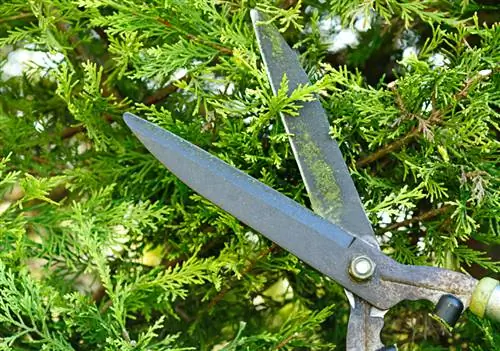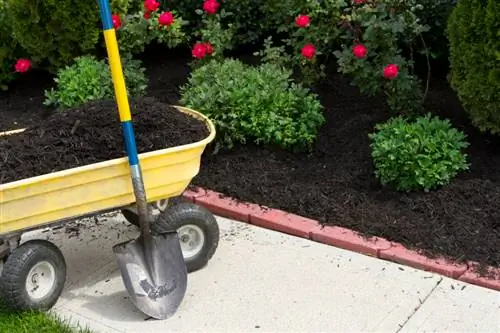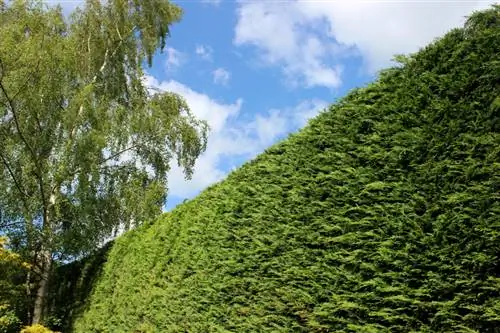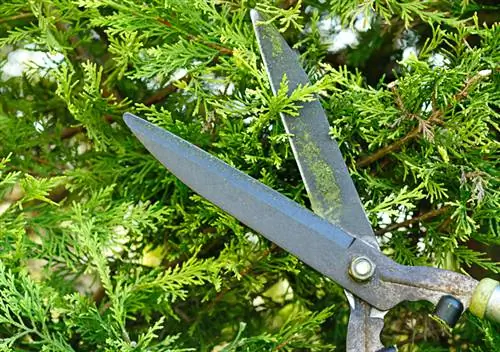- Author admin [email protected].
- Public 2023-12-25 17:45.
- Last modified 2025-01-23 11:22.
The false cypress opens up unimagined dimensions for creative garden design to hobby gardeners. The range of possibilities extends from delicate, evergreen ground cover to majestic solitaires. The following answers to frequently asked questions will show you how to properly cultivate this versatile conifer.
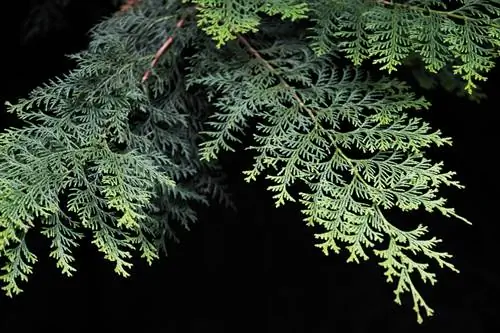
How do you care for a false cypress in the garden?
The false cypress is a versatile coniferous tree for garden design that prefers sunny locations and requires slightly acidic, fresh, humus-rich soil. Regular watering and fertilizing, as well as pruning depending on the variety, promote he althy growth. Attention: The plant is poisonous, so wear protective clothing.
Planting false cypress correctly
Before you put the young plant in the ground, the still potted root ball is soaked in water until no more air bubbles appear. Meanwhile, dig a pit with 1.5 times the volume of the root ball. Add mature compost, peat or leaf mold to the excavation. It is important to note that the planting depth is maintained during cultivation. After the soil has been compacted and watered, spread a layer of mulch with autumn leaves, grass clippings or bark mulch.read more
Care tips
The closer the location is to the ideal conditions, the less care the cypress requires from the gardener. This is how cultivation works:
- Keep the soil constantly slightly moist, both in the bed and in the pot
- You can choose to apply a long-term fertilizer in March and June or fertilize organically every 4 weeks
- Cut and thin out 1 to 2 times per season, depending on the variety, without cutting into the old wood
- Light winter protection is recommended in the year of planting and for potted trees
Please consider their toxic content when doing any work around the false cypresses. The protection of gloves and long-sleeved clothing should be avoided at any time.read more
Which location is suitable?
Cypresses have a sunny disposition. The closer the site conditions correspond to this characteristic, the more magnificent the growth. Temporary partial shade is tolerated; sooner or later results in disappointing stunting. If the coniferous tree finds fresh, humus-rich soil with a slightly acidic pH value, nothing stands in the way of a perfect habit with a dense needle cover.
What soil does the plant need?
Hobby gardeners form a lifelong friendship with a false cypress. This is even more true if the soil condition meets the requirements. Choose nutrient-rich, fresh, moist soil that is never waterlogged. As is typical for conifers, a slightly acidic pH value of 5 to 6 is considered ideal.
What is the best time to plant?
Planting time for young plants in containers is all year round, as long as it doesn't freeze or have a summer drought. You create optimal growth conditions if you plant the false cypress in sunny autumn soil. The time window is open from the end of August to mid-November. If there is no winter frost, the planting period continues throughout the cold season as long as the spade still penetrates the soil.
Cut cypress correctly
The rapid growth rate of most species and varieties requires regular and systematic pruning. To ensure that a false cypress develops a harmonious silhouette and does not become bare from the inside, proceed as follows:
- Depending on the variety, prune once or twice a year, in spring and late summer until August
- Due to the toxic content, wear gloves, eye protection and long-sleeved clothing
- Short branches that are too long so that they do not cut into the old wood
- Thoroughly thin out the entire tree at the same time
- Never dispose of toxic clippings on horse or livestock pastures
In order to give a false cypress the shape of a ball or pyramid, specialist retailers have special templates available. If you cultivate the coniferous tree as a hedge, cords stretched on wooden pegs serve as orientation. Ideally, you should give the hedge a trapezoidal shape with a wide base that tapers towards the top. In order to limit the amount of work, it makes sense to cut shortly after St. John's Day, June 24th. From this point onwards, the growth rate is reduced so that the accurate shape is maintained for longer.read more
Watering false cypress
Don't let a false cypress tree dry out, as the conifer usually doesn't recover from this. Primarily in the first few years, the plant is watered whenever the soil surface has dried out. Only use collected rainwater, decalcified tap water or pond water so that the pH value in the soil does not rise. Experience has shown that you should water more often in the bucket than in the bed. On hot summer days, check the watering requirement daily using a thumb test.
Fertilize false cypress properly
The nutrient requirements of a false cypress are at a low to medium level. Ring in this year's season with starting fertilization in March/April. This can be a mineral-organic long-term fertilizer that is administered again in June. You can optionally pamper the coniferous tree with a portion of compost and horn shavings every 4 weeks. For potted plants, we recommend a special conifer fertilizer in liquid form, which is applied according to the manufacturer's instructions.read more
Wintering
Adult false cypresses can cope well with a normal Central European winter. Light winter protection only makes sense in the planting year. Woody plants in the pot should also be protected from the rigors of the cold season. How to do it right:
- Put a breathable hood made of fleece or jute over young plants before the first frost
- Wrap the bucket in several layers of foil and place it on wood
- Cover the root disc with autumn leaves, brushwood or straw up to the root neck
- When there is frost in the bed and pot, water on mild days so that the root ball does not dry out
Adult false cypresses are protected from the intense winter sun with raffia or reed mats. There is no cause for alarm if the tips of the needles suffer frost damage. Simply cut off the affected damaged areas in the spring.
Propagate false cypress
The propagation of false cypresses is so easy that even the most novice hobby gardeners enjoy it. This is how it works:
- Take cuttings as cracklings between October and March
- Leave the lower part and plant two thirds in a pot with peat sand
- Put on a transparent hood and place it in a partially shaded, warm window seat
- Keep the substrate constantly moist and do not fertilize
If fresh shoots appear, the hood has done its job. Continue to care for the cuttings until they have completely rooted through the pot.
Is false cypress poisonous?
Experienced gardeners know that all conifers should be treated with caution. Unfortunately, the beautiful false cypress is no exception in this regard. The coniferous tree is very poisonous in all parts and therefore not suitable for the family garden. Please wear sturdy gloves, long pants and long-sleeved clothing during all planting and care work. Even slight skin contact can lead to very unpleasant inflammation. If shoots or cones are eaten intentionally or unintentionally, a doctor should be consulted immediately.read more
Beautiful varieties
- Winston Churchill: Impresses with its conical silhouette and golden-yellow needle leaves all year round; 15 m height
- Aurora: Historic yellow mussel cypress with a height of 100 cm; ideal for pots and small gardens
- White Spot: Innovative breeding that attracts everyone's attention with white tips on new shoots and columnar growth
- Elliwoodii: Beautiful, tightly upright cone shape, densely covered with mossy, blue needles; Growth height 200-300 cm
- Columnaris: classic for the evergreen hedge, thanks to rapid growth and shapely column silhouette


